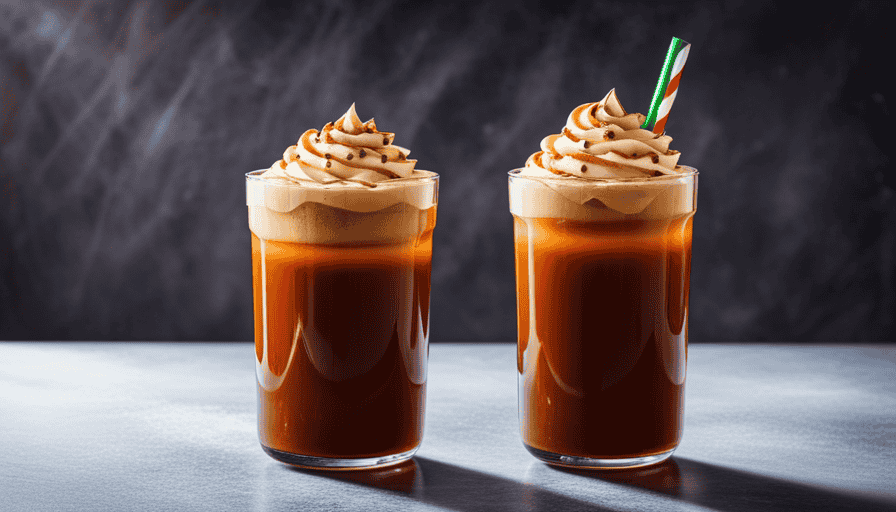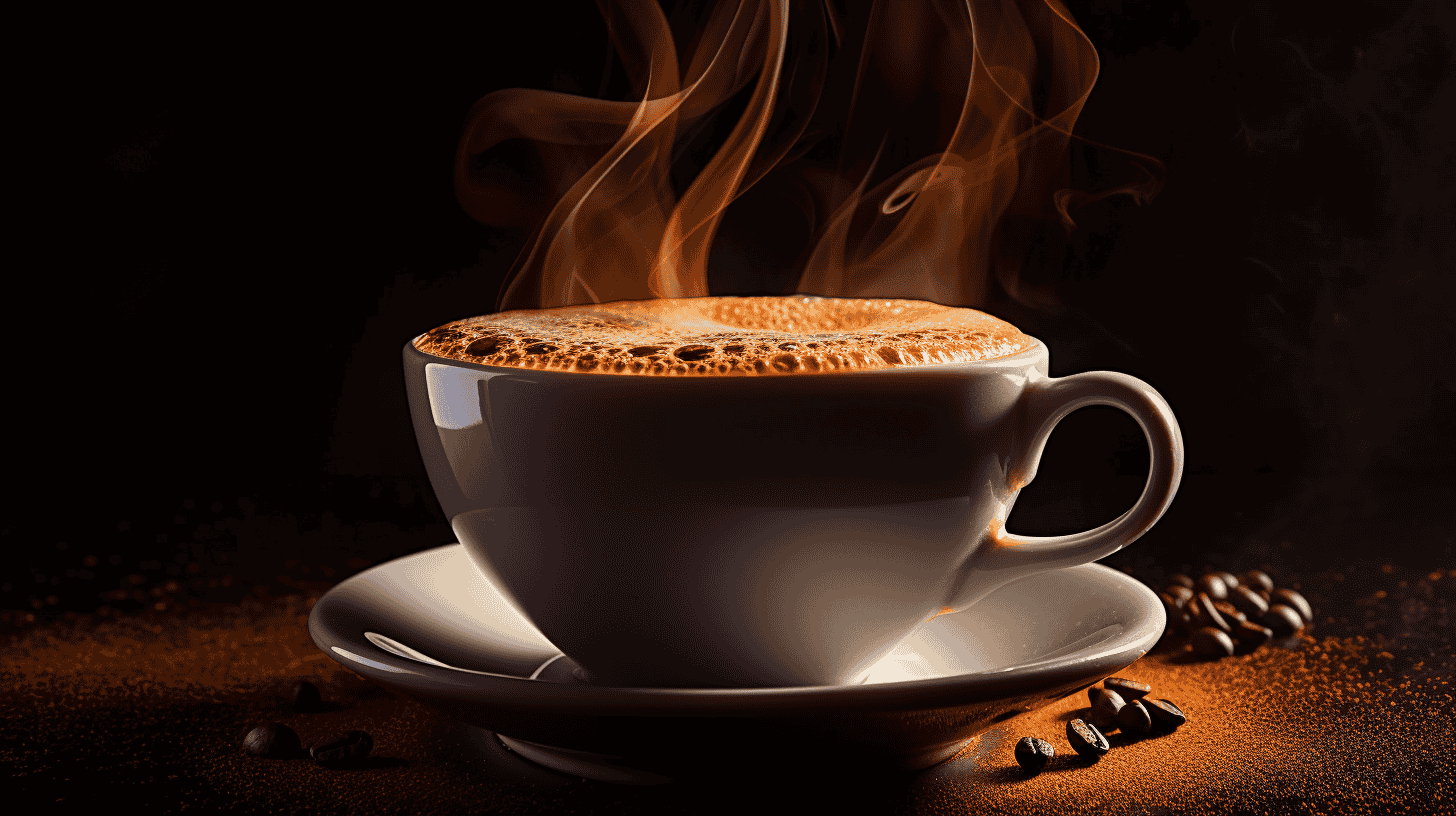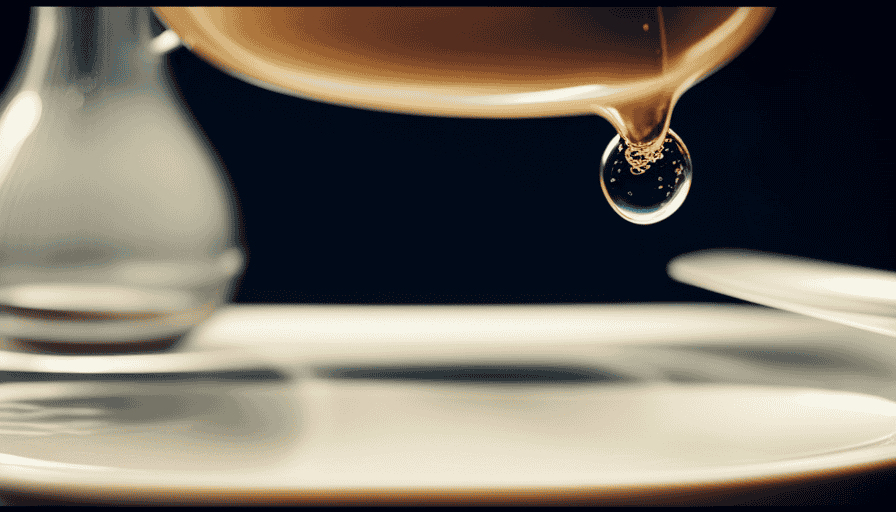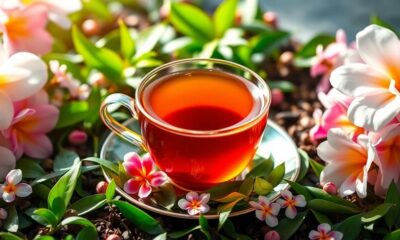Coffee Brewing Methods
The Ultimate Pumpkin Cream Cold Brew Recipe: Starbucks Copycat At Home!

I remember the crisp autumn morning when I first tasted the ultimate pumpkin cream cold brew from Starbucks. It was like sipping a slice of pumpkin pie in a cup, with its creamy, frothy goodness and rich coffee undertones.
From that moment on, I was hooked. But as a DIY enthusiast, I couldn’t resist the challenge of recreating this delectable drink at home. And let me tell you, after countless trials and taste tests, I’ve finally cracked the code on the perfect copycat recipe!
Imagine waking up to the enticing aroma of freshly brewed coffee, infused with the warm flavors of pumpkin spice. Picture yourself pouring a velvety smooth pumpkin cream cold foam over a glass of cold brew concentrate, creating a mesmerizing swirl of flavors. With each sip, you’ll experience the perfect balance of sweetness and coffee bitterness, enhanced by hints of vanilla and pumpkin.
In this article, I’ll walk you through the step-by-step process of creating your very own ultimate pumpkin cream cold brew. We’ll discuss the ingredients, preparation techniques, and even some tips and variations to cater to your personal preferences.
So grab your apron and get ready to embark on a coffee-infused pumpkin adventure right in the comfort of your own kitchen!
Key Takeaways
- Pumpkin cream cold brew has become more popular than the iconic Pumpkin Spice Latte as an autumn-themed drink.
- The recipe for pumpkin cream cold brew involves making various syrups and foams, including cold brew coffee concentrate, simple syrup, vanilla syrup, pumpkin spice syrup, and pumpkin cream cold foam.
- Monk fruit is a popular sweetener used in the recipe instead of sugar, and the recipe can be adapted to personal preferences and dietary needs.
- Making the pumpkin cream cold brew at home can be challenging but worth the effort, and the recipe can be doubled to share with others.
What is it?
I know that the pumpkin cream cold brew is a popular Starbucks drink that’s become the champion of autumn-themed beverages, dethroning the pumpkin spice latte.
One of the benefits of using monk fruit sweetener in the pumpkin cream cold brew recipe is that it offers a natural and healthier alternative to sugar. Monk fruit sweetener is known for its zero-calorie and low glycemic index properties, making it suitable for those watching their sugar intake.
Additionally, when it comes to the taste of fresh pumpkin puree versus canned pumpkin puree in the drink, using fresh pumpkin puree ensures that you’re getting 100% pure pumpkin flavor. Canned pumpkin puree may sometimes contain a mix of pumpkin and butternut squash.
The use of fresh pumpkin puree adds a natural and authentic pumpkin taste to the creamy and frothy coffee-infused beverage.
Ingredients and Preparation
To prepare the pumpkin cream cold brew, gather all the necessary ingredients and follow the step-by-step instructions. Here’s what you’ll need:
- Coarse ground coffee
- Water
- Monk fruit sweetener or maple syrup
- Vanilla extract
- Cream
- Salt
- Pumpkin puree
- Pumpkin pie spice
- Ginger
- Heavy cream
- Condensed milk
First, make the cold brew coffee concentrate by combining coarse ground coffee with water and letting it sit for 16 hours.
Then, make the simple syrup by boiling water and monk fruit sweetener or maple syrup until dissolved.
Next, simmer vanilla extract, scraped vanilla beans, cream, and salt to make the vanilla syrup.
For the pumpkin spice syrup, combine pumpkin puree, pumpkin pie spice, ginger, and salt with either cream or sweetened condensed milk.
Finally, whisk together heavy cream, condensed milk, pumpkin puree, pumpkin spice, and vanilla extract to create the pumpkin cream cold foam.
To add a twist to your recipe, consider using alternative sweeteners like stevia or honey instead of monk fruit sweetener. You can also elevate the flavor by using homemade pumpkin puree instead of canned. Simply roast and blend fresh pumpkin until smooth.
These small changes can make a big difference in the taste of your pumpkin cream cold brew. So gather your ingredients and let’s get started!
Step-by-Step Instructions
Let’s dive into the step-by-step instructions and create a delicious homemade version of this popular autumn drink, shall we?
First, let’s learn how to make cold brew coffee at home. Combine coarse ground coffee with water, let it sit for 16 hours, then strain it to get the cold brew concentrate.
Now, if you’re looking for a vegan alternative for the pumpkin cream cold brew, you can substitute the dairy-based ingredients with coconut milk. To make the coconut milk sweetened condensed milk, simmer coconut milk and monk fruit sweetener for 45 minutes.
Once you have your cold brew and vegan sweetened condensed milk ready, it’s time to assemble the drink. Pour the syrups into glasses, followed by cold brew concentrate and water. Top it off with the pumpkin cream cold foam and pumpkin spice topping.
And there you have it, your very own homemade pumpkin cream cold brew!
Tips and Variations
When experimenting with the pumpkin cream cold brew recipe, it’s fun to try different variations like adding a sprinkle of cinnamon or a drizzle of caramel syrup for an extra flavor boost.
But did you know that you can also make vegan alternatives of this delicious drink? Instead of using dairy-based ingredients, you can substitute coconut milk for a creamy and vegan twist.
And if you’re looking to customize the flavors even further, you can try adding a dash of nutmeg or a pinch of cloves to the pumpkin spice syrup.
The options are endless when it comes to flavor customization with the pumpkin cream cold brew. Whether you’re a pumpkin lover or looking for a dairy-free option, this recipe can be adapted to suit your preferences and dietary needs.
So go ahead and get creative with your own unique twist on this autumn-inspired drink!
History and Popularity
Surprisingly, the pumpkin cream cold brew has a rich history and has gained immense popularity in recent years. It’s made a significant impact on the pumpkin spice industry, dethroning the iconic pumpkin spice latte as the champion of autumn-themed drinks. This delicious beverage has captured the hearts of coffee lovers with its creamy, rich, and frothy texture, making it the ultimate indulgence.
Here are three reasons why the pumpkin cream cold brew has become such a sensation:
-
Unprecedented Flavor: With the perfect balance of coffee and pumpkin spice, this drink is like sipping on a creamy, coffee-infused pumpkin pie. It offers a unique and irresistible flavor that has captivated taste buds everywhere.
-
Versatility: While other autumn-themed drinks like apple cider and hot chocolate are delicious in their own right, the pumpkin cream cold brew stands out for its ability to be enjoyed hot or cold. This versatility allows coffee enthusiasts to indulge in their favorite autumn flavors all year round.
-
Healthier Alternative: Unlike its predecessor, the pumpkin spice latte, the pumpkin cream cold brew recipe can be adapted to suit different dietary needs. By using monk fruit as a natural sweetener and substituting dairy-based ingredients with alternatives like coconut milk, it can be enjoyed by vegans and those looking for a healthier option.
The pumpkin cream cold brew has not only revolutionized the pumpkin spice industry but also offers a delightful and customizable experience for coffee enthusiasts. Its rich history and ever-growing popularity are a testament to its irresistible taste and versatility.
Frequently Asked Questions
How long does it take to make the pumpkin cream cold brew recipe?
Preparation time for the pumpkin cream cold brew recipe varies depending on the steps involved. Making the cold brew coffee concentrate takes about 16 hours, while preparing the simple syrups and pumpkin spice syrup can be done relatively quickly.
To speed up the process, consider using store-bought syrups or pre-made pumpkin spice mix. Chilling the glasses in the freezer beforehand also helps to keep the drink cold.
With a little planning and these tips, you can enjoy a delicious pumpkin cream cold brew in no time.
Can I use a different type of sweetener instead of monk fruit in the recipe?
Yes, you can definitely use a different type of sweetener instead of monk fruit in the pumpkin cream cold brew recipe. There are several alternatives you can try, such as stevia, erythritol, or even maple syrup. These sweeteners can provide a similar level of sweetness without the added calories of regular sugar. Feel free to experiment and find the one that suits your taste preferences and dietary needs.
Is it necessary to use fresh pumpkin puree, or can I use canned pumpkin puree?
Using fresh pumpkin puree in recipes is like adding a secret ingredient that elevates the flavors to a whole new level. While canned pumpkin puree can be convenient, opting for fresh pumpkin puree offers several benefits.
Fresh pumpkin puree is made from real pumpkins, ensuring a 100% pumpkin flavor and avoiding any potential inclusion of other squash varieties. It also allows for more control over the texture and consistency of the puree.
So, if you have the time and want to enhance the authenticity of your pumpkin cream cold brew, fresh pumpkin puree is definitely worth considering.
Can I make the pumpkin cream cold brew recipe without dairy-based ingredients?
Yes, you can definitely make the pumpkin cream cold brew recipe without dairy-based ingredients. There are vegan alternatives and non-dairy options that can be used to recreate this delicious drink. For example, you can substitute coconut milk for the heavy cream and condensed milk in the pumpkin cream cold foam. Additionally, you can make vegan sweetened condensed milk using coconut milk and monk fruit sweetener. These substitutions will ensure that the recipe is dairy-free while still maintaining its creamy and frothy texture.
Are there any alternatives to the pumpkin spice syrup in the recipe?
Yes, there are alternatives to the pumpkin spice syrup in the recipe that are also dairy-free. One option is to use a combination of cinnamon, nutmeg, ginger, and cloves to create your own pumpkin spice blend. You can adjust the ratios to suit your taste preferences.
Another alternative is to use a pumpkin spice flavored syrup that’s specifically labeled as dairy-free. These options allow you to enjoy the delicious flavors of pumpkin spice without compromising your dietary needs.
Conclusion
In conclusion, the ultimate pumpkin cream cold brew recipe is an irresistible Starbucks copycat that can easily be made at home. This creamy and frothy autumn-themed drink has gained immense popularity, even surpassing the iconic pumpkin spice latte.
By following the step-by-step instructions and using high-quality ingredients, you can create a delicious coffee-infused pumpkin pie in a cup.
One interesting statistic to note is that sales of pumpkin-flavored beverages have increased by 20% in the past year, showing just how much people love this seasonal treat.
So why not indulge in the ultimate pumpkin cream cold brew and enjoy the flavors of fall right at home?
Noah, the Editor-in-Chief at Cappuccino Oracle, plays a pivotal role in shaping the voice and vision of our renowned platform. With an unwavering passion for coffee, coffee alternatives, and tea, Noah leads Cappuccino Oracle towards new horizons in the realm of coffee journalism.
Beyond his professional responsibilities, Noah serves as a mentor and guiding force for his team. His dedication to journalistic excellence and genuine love for coffee, coffee alternatives, and tea continue to inspire and motivate the Cappuccino Oracle family. In the ever-evolving world of these beverages, Noah’s leadership ensures that our platform remains at the forefront, delivering enlightening and enjoyable content to our readers worldwide.
Coffee Brewing Methods
What Is Coffee Powder? A Guide To Instant Coffee And Its Benefits

Instant coffee, also referred to as coffee powder, offers a quick and convenient solution for coffee lovers to savor their preferred drink. Its ease of preparation has made it a household essential for numerous coffee aficionados.
But what exactly is coffee powder and how is it made?
Coffee powder is made by roasting coffee beans, grinding them, brewing the coffee, and then removing the water to create a dissolvable powder. This process ensures that all the flavors and aromas of the coffee beans are captured in the powder, allowing for a rich and flavorful cup of coffee.

One interesting statistic to note is that coffee powder and ground coffee are not the same. Instant coffee has already undergone the entire coffee-making process, making it different from ground coffee.
In addition to its convenience, coffee powder also provides the same nutrients as a standard cup of coffee. However, it is important to consume it in moderation as it contains caffeine. Reading nutrition labels and checking caffeine quantities is essential to avoid unintentional overdosing.
In this article, we will delve deeper into the world of coffee powder, exploring its production process, caffeine content, and safety considerations. So grab a cup of coffee, sit back, and let’s explore the wonders of coffee powder together.
Key Takeaways
- Coffee powder, also known as instant coffee, is a convenient way to enjoy coffee.
- It is important to consume coffee powder in moderation due to its caffeine content.
- Coffee powder provides the same nutrients as a standard cup of coffee.
- Coffee powder production has environmental impacts, but efforts are being made to reduce them through sustainable practices and technologies.
What is it?
Coffee powder, also known as instant coffee, is a soluble form of coffee made by roasting, grinding, brewing, and dehydrating coffee beans. This process results in a dissolvable powder that can be consumed as a beverage or used in cooking.
There are different types of coffee powders available, with varying flavors and strengths to suit individual preferences. One of the main advantages of coffee powder is its convenience and ease of use. It can be quickly dissolved in hot water, eliminating the need for brewing equipment or waiting for a pot of coffee to brew.
Additionally, coffee powder offers several health benefits. It contains antioxidants that help protect cells from damage, and it has been associated with a reduced risk of various diseases, including type 2 diabetes, Parkinson’s disease, and liver cancer. However, it is important to consume coffee powder in moderation, as it can also have negative effects on sleep, anxiety, and digestive health.
How it’s Made
To produce coffee powder, coffee beans are first roasted, then ground, brewed, and finally dehydrated through either spray-drying or freeze-drying methods.
-
Spray-drying involves spraying a liquid coffee extract into a hot chamber, where the water evaporates, leaving behind dried coffee particles.
-
Freeze-drying, on the other hand, involves freezing the brewed coffee and then placing it in a vacuum chamber. The frozen water in the coffee sublimates, turning directly into vapor and leaving behind freeze-dried coffee particles.
Pros and cons of these manufacturing methods include:
-
Spray-drying is a faster and more cost-effective process, but it can result in a loss of flavor and aroma due to the high heat involved.
-
Freeze-drying preserves the flavor and aroma better, but it is a slower and more expensive process.
The environmental impact of coffee powder production includes energy consumption, water usage, and waste generation from the manufacturing processes. Efforts are being made to reduce these impacts through sustainable practices and technologies.
Caffeine Content and Safety
The caffeine content in coffee powder should be taken into consideration to ensure safe consumption. Different coffee brands may vary in their caffeine content, and it is important to be aware of the levels present in the product.
Consuming excessive amounts of caffeine can have various health effects. While caffeine can provide temporary alertness and improved cognitive function, excessive consumption can lead to negative side effects such as restlessness, insomnia, increased heart rate, and even anxiety. It is essential to be mindful of one’s caffeine intake, as exceeding the recommended daily limit can have adverse effects on health.
Therefore, it is advisable to check the caffeine quantities mentioned on the packaging of coffee powder and other coffee-related products to avoid unintentional overdosing. Moderation is key when it comes to consuming caffeine-rich beverages.
Frequently Asked Questions
How long does coffee powder last after it has been opened?
The shelf life of opened coffee powder depends on several factors, including storage conditions and the type of packaging. Generally, coffee powder can last for several months to a year after it has been opened.
To extend its shelf life, it is important to store it in an airtight container in a cool, dark place away from moisture and heat. Following these storage tips can help maintain the flavor and freshness of the coffee powder for a longer period of time.
Can coffee powder be used to make espresso?
Coffee powder can be used as an alternative to espresso, but it may not provide the same depth and intensity of flavor. When choosing a coffee powder for espresso, it is important to consider the roast level and grind size. Darker roasts and finer grinds tend to produce a more espresso-like flavor. However, it is important to note that instant coffee may not be able to replicate the crema and richness that is characteristic of a true espresso shot.
Is coffee powder suitable for people with acid reflux or sensitive stomachs?
For individuals with acid reflux or sensitive stomachs, coffee powder may not be the best option. However, there are coffee powder alternatives that are considered to be more suitable.
One interesting statistic is that low acid coffee, such as those made from beans processed with the Swiss Water Method, can have up to 70% less acid compared to regular coffee.
These alternatives provide a milder and less irritating option for individuals with acid reflux or sensitive stomachs.
Can coffee powder be used in baking recipes?
Coffee powder can indeed be used in baking recipes to add a rich coffee flavor to desserts. It is important to note that coffee powder is different from instant coffee. Instant coffee is already brewed and dehydrated, while coffee powder is simply the powdered form of ground coffee beans.
When using coffee powder in baking, it can be dissolved in a small amount of hot water before adding it to the recipe. This will ensure that the coffee flavor is evenly distributed throughout the dessert.
So, coffee powder can be a great addition to various desserts, such as cakes, cookies, and brownies, to enhance their taste with a hint of coffee.
Does coffee powder have the same antioxidant benefits as freshly brewed coffee?
Coffee powder, also known as instant coffee, contains a similar antioxidant content as freshly brewed coffee. Antioxidants are compounds that help protect against oxidative stress and reduce the risk of chronic diseases.
Instant coffee is made from roasted coffee beans, ground, brewed, and then dehydrated to form a powder. While the drying process may slightly reduce the antioxidant levels compared to freshly brewed coffee, instant coffee still provides health benefits associated with antioxidants.
Conclusion
In conclusion, coffee powder, also known as instant coffee, is a convenient and popular option for coffee lovers. It is made through a process of roasting, grinding, brewing, and drying coffee beans.
This dissolvable powder offers the same nutrients as a standard cup of coffee and can be consumed by dissolving it in hot water or incorporating it into recipes. However, it is crucial to be mindful of the caffeine content and consume it in moderation.
An interesting statistic to note is that coffee is the second most traded commodity in the world, after oil, highlighting its global popularity and significance.
Noah, the Editor-in-Chief at Cappuccino Oracle, plays a pivotal role in shaping the voice and vision of our renowned platform. With an unwavering passion for coffee, coffee alternatives, and tea, Noah leads Cappuccino Oracle towards new horizons in the realm of coffee journalism.
Beyond his professional responsibilities, Noah serves as a mentor and guiding force for his team. His dedication to journalistic excellence and genuine love for coffee, coffee alternatives, and tea continue to inspire and motivate the Cappuccino Oracle family. In the ever-evolving world of these beverages, Noah’s leadership ensures that our platform remains at the forefront, delivering enlightening and enjoyable content to our readers worldwide.
Coffee Brewing Methods
The Art Of Cold Brew: Mastering The Perfect Ratio

Cold brew coffee has gained immense popularity for its velvety flavor and invigorating effects. It is essential to attain the ideal balance of coffee and water for achieving the desired taste.
The general consensus for cold brew is a 1:5 ratio, but experimentation is encouraged to find the preferred taste. Properly soaking coarsely ground coffee beans is essential for extracting the flavors.
It is advisable to only make what will be consumed to avoid waste, as cold brew can last up to a week in the refrigerator. Surprisingly, cold brew can be stronger than hot coffee, depending on the ratio used. Dilution with water or ice is unnecessary, as it is already factored into the drink.
Personal preference plays a significant role in determining the strength of cold brew, and the taste can be adjusted through dilution or mixing with other ingredients such as sweetened milk or liquid sugar.
With the knowledge of cold brew ratios, one can craft the perfect cup of cold brew and customize its strength according to their liking.
Key Takeaways
- The proportion of coffee to water is crucial in making cold brew.
- The general consensus for cold brew is a 1:5 proportion of coffee to water.
- Experimentation with ratios is encouraged to find the preferred taste.
- Properly soaking the coarsely ground coffee beans is important.
What is Cold Brew?
Cold brew is a method of coffee extraction that involves steeping coarsely ground coffee beans in cold water for an extended period of time, resulting in a smooth, low-acid coffee concentrate.
Unlike iced coffee, which is brewed with hot water and then cooled down, cold brew is made by using only cold water throughout the entire brewing process.
This slow extraction method enhances the flavor profile of the coffee, resulting in a beverage that is less bitter and acidic compared to traditional brewing methods.
Additionally, cold brew offers health benefits such as reduced acidity, which can be beneficial for individuals with sensitive stomachs.
The lower acidity also makes cold brew a more teeth-friendly option, as it is less likely to cause enamel erosion.
Ratio Importance
The key to achieving the ideal taste in cold brew lies in finding the precise balance between the amount of coffee and water used, as this proportion directly impacts the flavor profile and strength of the final product, analogous to the delicate interplay of notes in a symphony.
Exploring different ratios allows for customization and experimentation, enabling cold brew enthusiasts to find the perfect balance that suits their taste preferences. While the general consensus for cold brew is a 1:5 ratio of coffee to water, personal preference plays a significant role in determining the preferred strength.
Dilution with additional water or ice is not necessary, as it is already factored into the drink. It is essential to properly soak the coarsely ground coffee beans to extract the desired flavors and avoid any bitterness.
By mastering the art of finding the perfect ratio, one can craft a cold brew that is both smooth and invigorating.
Tips for Brewing
To achieve optimal results when brewing cold brew coffee, it is beneficial to follow a few helpful tips.
Firstly, ensure that you are using the correct coffee to water ratio. The general consensus for cold brew is a 1:5 proportion of coffee to water, but feel free to adjust this ratio to suit your personal taste preferences.
Additionally, choose high-quality, freshly-ground coffee beans for maximum flavor extraction. Coarsely ground beans work best for cold brew, as they allow for a slower extraction process.
When soaking the coffee grounds, make sure they are fully submerged in water and stir gently to ensure even saturation.
Steep the mixture in the refrigerator for at least 12 hours, or up to 24 hours for a stronger brew.
Finally, strain the mixture through a fine mesh sieve or a coffee filter to remove any sediment.
By following these tips, you can maximize the flavor and enjoyment of your cold brew coffee.
Frequently Asked Questions
Can I use any type of coffee to make cold brew, or are there specific types that work better?
While any type of coffee can be used to make cold brew, certain coffee bean varieties work better due to their flavor profiles. Different coffee bean varieties can result in varying taste profiles, acidity levels, and strength in cold brew.
Some popular choices for cold brew include medium to dark roast beans, which tend to have a richer and bolder flavor. Additionally, brewing methods such as immersion or slow drip can also impact the taste and strength of the cold brew.
How long should I steep the coffee beans in water to achieve the desired strength of cold brew?
The steeping time for cold brew and the best coffee beans to use are important factors in achieving the desired strength of cold brew.
The duration of steeping the coffee beans in water varies depending on personal preference. Generally, a steeping time of 12-24 hours is recommended for a strong and flavorful cold brew. However, some individuals prefer a longer steeping time of up to 48 hours for a bolder taste.
It is important to choose coffee beans specifically labeled for cold brew as they are coarsely ground and have the ideal flavor profile for this brewing method.
Can I make cold brew in larger batches and store it for longer than a week in the refrigerator?
In the realm of cold brew coffee, the quest for the perfect ratio is akin to an artist striving for their masterpiece.
When it comes to storing larger batches of cold brew for an extended period in the refrigerator, caution must be exercised.
While cold brew can be made in larger quantities, it is recommended to consume it within a week for optimal freshness. Prolonged refrigeration may result in a decline in taste and quality.
Therefore, it is best to craft smaller batches to savor the true essence of cold brew.
Is it necessary to use coarsely ground coffee beans for cold brew, or can I use a different grind size?
Different grind sizes for cold brew can affect the quality and taste of the final product. While it is not necessary to use coarsely ground coffee beans for cold brew, it is highly recommended. Coarsely ground coffee allows for a slower extraction process, resulting in a smoother and less bitter brew.
Finely ground coffee can lead to over-extraction and a more acidic taste. Therefore, using coarsely ground coffee beans provides the benefits of a better flavor profile and a more enjoyable cold brew experience.
Can I use hot water instead of cold water to make cold brew, or will it affect the taste?
Using hot water for cold brew: pros and cons
The temperature of the water significantly affects the extraction process and flavor of cold brew.
Using hot water for cold brew has both pros and cons. Hot water can extract flavors more quickly, resulting in a shorter brewing time. However, it can also lead to over-extraction, resulting in a bitter taste.
Cold water, on the other hand, allows for a slower extraction process, resulting in a smoother and less acidic flavor.
Therefore, using hot water for cold brew can alter the taste and may not achieve the desired flavor profile.
Noah, the Editor-in-Chief at Cappuccino Oracle, plays a pivotal role in shaping the voice and vision of our renowned platform. With an unwavering passion for coffee, coffee alternatives, and tea, Noah leads Cappuccino Oracle towards new horizons in the realm of coffee journalism.
Beyond his professional responsibilities, Noah serves as a mentor and guiding force for his team. His dedication to journalistic excellence and genuine love for coffee, coffee alternatives, and tea continue to inspire and motivate the Cappuccino Oracle family. In the ever-evolving world of these beverages, Noah’s leadership ensures that our platform remains at the forefront, delivering enlightening and enjoyable content to our readers worldwide.
Coffee Brewing Methods
The Art Of Brewing Perfect Espresso At Home

In the quest for the ultimate espresso, there exists an artistic skill that goes beyond the routine task of preparing coffee. It is a careful procedure that requires constant focus on every detail, a steadfast dedication to maintaining consistency, and an unbreakable passion for the trade.
Brewing the perfect espresso at home is not for the faint of heart; it requires a deep understanding of the essential steps, the right techniques, and the precise measurements. Like a virtuoso composing a symphony, the home barista must master the delicate dance of grinding and tamping, the intricate art of milk steaming, and the artful balance of flavors.
With each sip, a harmonious symphony of taste unfolds, awakening the senses and transporting the drinker to a realm of pure bliss. Join us on this journey as we unlock the secrets of the art of brewing perfect espresso at home, and embark on a quest to elevate your coffee experience to new heights.
Key Takeaways
- Pursuit of perfect espresso requires art, attention to detail, consistency, and dedication.
- Brewing perfect espresso at home requires understanding essential steps, techniques, and measurements.
- Home baristas must master grinding, tamping, milk steaming, and flavor balance.
- The key to brewing a perfect espresso lies in the harmonious symphony of taste achieved through essential steps such as setting the grinder, using the right amount of ground coffee, tamping evenly, timing the shot, and adjusting based on taste indicators.
Essential Steps
The essential steps in brewing perfect espresso at home include:
- Setting the grinder to a fine grind size
- Using around 20 grams of ground coffee in the portafilter
- Evenly and firmly tamping the grounds
- Timing the shot to hit 60 ml in 20-30 seconds
- Adjusting the grind size and extraction based on taste indicators such as sourness or bitterness
Preheating equipment, such as the espresso maker, is also crucial to ensure consistent results. Additionally, the dialing in process, which involves adjusting the grind size and extraction time, may need to be repeated when switching between different coffee roasts.
By following these steps and techniques, coffee enthusiasts can achieve the perfect balance of flavors and aromas in their homemade espresso.
Grinding and Tamping
Grinding and tamping are essential steps in the espresso-making process. The grind size selection plays a crucial role in determining the quality of the extraction. A fine grind size is typically preferred for espresso, as it allows for a slower extraction and enhances the flavors. However, finding the perfect grind size may require some experimentation and adjustments to achieve the desired taste profile.
Tamping, on the other hand, involves evenly pressing the ground coffee in the portafilter with the right amount of pressure. This step ensures that water passes through the coffee evenly during extraction, avoiding channeling and promoting consistent extraction. Tamping straight and level is important to prevent any inconsistencies in the extraction process.
By mastering the art of grinding and tamping, one can achieve a superior espresso shot with optimal flavor and aroma.
Milk Steaming Techniques
Milk steaming techniques play a crucial role in achieving the desired consistency and temperature for milk-based espresso drinks.
The temperature of the milk is a key factor in creating a creamy and velvety texture, while the frothing techniques determine the amount and quality of foam.
A common technique is to position the steam wand just below the surface of the milk, creating a whirlpool effect to incorporate air and create microfoam.
The aim is to achieve a temperature of around 150°F (65°C) and a smooth, glossy texture.
It is important to practice and experiment with different techniques to find the perfect balance between heating the milk and creating the desired amount of foam.
With consistent practice and attention to detail, mastering milk steaming techniques will enhance the overall espresso experience.
Frequently Asked Questions
What is the ideal water temperature for brewing espresso at home?
The ideal water temperature for brewing espresso at home is between 195°F and 205°F (90°C and 96°C). This temperature range is crucial in extracting the flavors and aromas from the coffee beans.
Additionally, it ensures that the espresso shot is not under-extracted or over-extracted, resulting in a balanced and flavorful cup of coffee.
Using freshly roasted coffee beans is also essential as they possess more volatile compounds that contribute to the rich and complex flavors in the espresso shot.
Can I use pre-ground coffee for brewing espresso?
Using pre-ground coffee for brewing espresso can be done, but it may not produce the best results. The key to achieving a high-quality espresso lies in the freshness of the coffee grounds. Pre-ground coffee tends to lose its flavor and aroma over time, resulting in a less satisfying espresso.
To truly experience the nuances and complexity of espresso, it is recommended to invest in a good espresso machine and follow a step-by-step espresso brewing guide. This will ensure that you have control over the grind size, dosage, and extraction time, allowing you to achieve the perfect espresso shot.
How often should I clean my espresso machine?
Regularly cleaning and descaling your espresso machine is of utmost importance. Neglecting this essential task will result in subpar espresso and potential damage to your machine.
To maintain optimal performance, deep clean your espresso machine at least once a month. Use a mixture of water and vinegar or a commercial descaling solution to remove mineral buildup.
Additionally, regularly clean removable parts such as the portafilter, steam wand, and drip tray to prevent the buildup of coffee residue and ensure a consistently delicious brew.
What is the recommended ratio of coffee to water for brewing espresso?
The recommended ratio of coffee to water for brewing espresso is around 20 grams of ground coffee to produce 60 ml of espresso shot within 20-30 seconds.
To achieve the perfect extraction time, it is crucial to set the grinder to a fine grind size and tamp the grounds evenly and with pressure. This ensures consistent extraction and avoids under or over-extraction.
Adjusting the grind size may be necessary to fine-tune the extraction process.
Are there any alternative milk options for steaming and frothing?
Alternative milk options for steaming and frothing can be used to achieve the perfect microfoam for latte art.
Non-dairy milk options such as almond milk, soy milk, oat milk, and coconut milk offer alternatives for those who are lactose intolerant or prefer plant-based options.
These alternatives can produce a creamy and frothy texture similar to dairy milk when steamed properly.
Experimenting with different milk options and techniques is crucial to achieving the desired results in latte art with non-dairy milk.
Noah, the Editor-in-Chief at Cappuccino Oracle, plays a pivotal role in shaping the voice and vision of our renowned platform. With an unwavering passion for coffee, coffee alternatives, and tea, Noah leads Cappuccino Oracle towards new horizons in the realm of coffee journalism.
Beyond his professional responsibilities, Noah serves as a mentor and guiding force for his team. His dedication to journalistic excellence and genuine love for coffee, coffee alternatives, and tea continue to inspire and motivate the Cappuccino Oracle family. In the ever-evolving world of these beverages, Noah’s leadership ensures that our platform remains at the forefront, delivering enlightening and enjoyable content to our readers worldwide.
-

 Coffee Alternatives And Tea4 weeks ago
Coffee Alternatives And Tea4 weeks agoThe Coffee Alternative That’s Helping People Live to 100
-

 Coffee Alternatives And Tea2 weeks ago
Coffee Alternatives And Tea2 weeks agoNutritionists Are Raving About This Coffee Alternative – Here’s Why
-

 Coffee, Tea and Alternatives and Health plus Fitness2 weeks ago
Coffee, Tea and Alternatives and Health plus Fitness2 weeks agoThe Shocking Reason Health Experts Are Abandoning Green Tea
-

 Coffee Alternatives And Tea2 weeks ago
Coffee Alternatives And Tea2 weeks agoThe ‘Miracle Tea’ That’s Helping People Sleep Better Than Ever
-

 Coffee Alternatives And Tea2 weeks ago
Coffee Alternatives And Tea2 weeks agoThis Coffee Substitute Promises to Double Your Productivity
-

 Coffee Alternatives And Tea2 weeks ago
Coffee Alternatives And Tea2 weeks agoThe Tea That’s So Good, It’s Causing Shortages Worldwide
-

 Coffee Alternatives And Tea1 week ago
Coffee Alternatives And Tea1 week agoThe ‘Super Brew’ That’s Making Energy Drinks Look Like Soda
-

 Coffee Alternatives And Tea1 week ago
Coffee Alternatives And Tea1 week agoThe Tea That Claims to Reverse Aging – Is It Too Good to Be True?



























